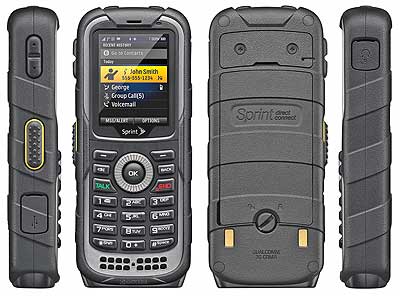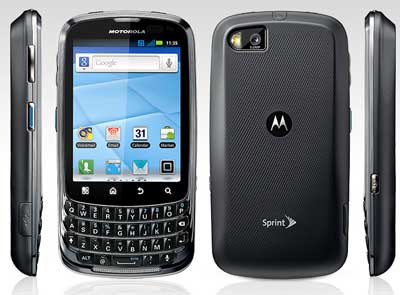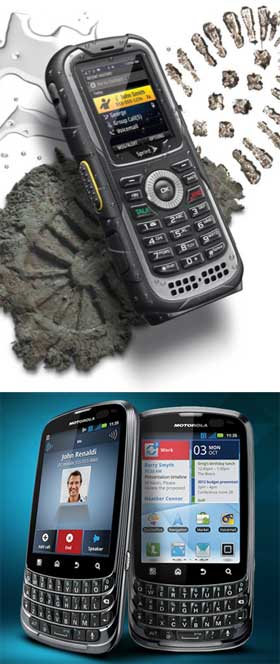|
Sprint gets rugged
Are Sprint's ruggedized phones an alternative to dedicated rugged handhelds?
(by Conrad H. Blickenstorfer)
For decades, the decision whether to get dedicated rugged handheld computers or just cellphones for jobs out there in the field was simple. Computers were computers, and phones were phones. That began changing a few years ago when handhelds added phone capabilities and phones became little computers, but the difference between the two types of devices was still substantial.  Well, not anymore. Phones have become smartphones that are computers, they run industrial strength operating systems, their displays have grown in size and resolution, and they are perfectly capable of running even complex applications. What's more, almost everyone is familiar with smartphones and how they work, so why not use them on the job as well? Oh, and they also cost less than dedicated handheld computers. As a result, many enterprises are now using iPhones and Android phones by the hundreds and thousands. Well, not anymore. Phones have become smartphones that are computers, they run industrial strength operating systems, their displays have grown in size and resolution, and they are perfectly capable of running even complex applications. What's more, almost everyone is familiar with smartphones and how they work, so why not use them on the job as well? Oh, and they also cost less than dedicated handheld computers. As a result, many enterprises are now using iPhones and Android phones by the hundreds and thousands.
But using a standard consumer phone in the field is not always the answer. That's because while consumer phones are generally built to take a bit of abuse, they are not truly rugged. They may or may not survive a drop or a good splash, and when you depend on your handheld for your job, that's just not good enough. And then there's security, maintenance, and support — the stuff corporate IT is concerned about. And that's why most of the traditional makers of ruggedized handheld computers now also offer versions that include full phone functionality and work very much like smartphones. Problem is, most of those still cost a lot more, and most still run Windows Mobile and not the iOS or Android that all those hundreds of millions of smartphone users are already used to.
At this point no one knows how it'll all shake out, whether conventional rugged handhelds are doomed or not, or even what OS platform will run on mobile workers' devices a couple of years from now. This may be why Sprint started its "Sprint Gets Rugged" initiative a while ago. It was started to help developers migrate their enterprise apps to Sprint's line of ruggedized CDMA devices. The program offers developer software, testing tools and devices, and also migrating of iDEN apps (those push-to-talk apps from the NEXTEL days) to Sprint CDMA Java or Android devices. So we thought we'd take a look at some of those rugged phones available in the Sprint Gets Rugged program and see what they are like.
Kyocera DuraPlus
First up, the Sprint DuraPlus by Kyocera. There's no doubt that this is a tough phone. Even the box shows a guy with a hard hat. And it says right on the box: "Military standard 810G ruggedized for dust, shock, vibration, temperature extremes, blowing rain, low pressure, solar radiation, salt fog, humidity, and immersion for up to 30 minutes in up to 1 meter (3.28 ft) of water." The specs don't say what exactly the DuraPlus was tested for and how much abuse it can handle, but it's pretty clear that this phone won't easily break or let you down.

In terms of size and weight, the DuraPlus measures 5.3 x 2.2 x 0.93 inches and weighs less than seven ounces. Compared to how large and heavy cellphones were just a few short years ago, that's downright tiny. The DuraPlus with its soap bar styling may be thicker than today's cookie cutter smartphones, but it can clean hide behind one of those new mini-slates with their ever larger displays. There's a good old-fashioned physical keypad and navigation ring, so there's only enough space for a small 2-inch 240 x 320 pixel QVGA display. No touch here, and the OS is proprietary, which means you do things the way they used to be done on phones, mostly via lists. The screen is bright and very sharp, definitely outdoor-viewable, and it has a perfect viewing angle from all directions.
In terms of functionality, the DuraPlus is a veritable Swiss Army knife, but it does things the old-fashioned way. No zooming and pinching and no apps that calculate the calorie content of semi-fat Brie here, and only WAP (remember that?) and not the real web. Even the absence of a camera is a feature: this way you can use the phone where no cameras are allowed. Instead, you get industrial-strength next-gen push-to-talk via Sprint Direct Connect; excellent, loud sound for when it gets noisy out there; a very strong LED flashlight in the nose of the phone for when it gets dark; and if the DuraPlus falls into a puddle or even a brook, no big deal. It's totally waterproof.
And how much does it cost? Just US$269.99, and much less if you sign up for a 2-year service agreement. That is a whole lot more economical than any rugged handheld with phone functionality. But since it's proprietary it'll run, besides the limited built-in functions, only whatever apps are specifically written for it. As long as those limitations are clear, the DuraPlus can be a real deal.
Motorola Admiral
Compared to the tough, stark and rather conventional DuraPlus, the Motorola Admiral looks several generations newer. Not new-new, mind you, but new as in a Blackberry-style smartphone with one of those tiny thumbtype QWERTY keyboards. The Admiral, though, is quite up-to-date on the OS side of things. It's Android; not the latest version, but there's multi-touch and all the good panning and pinching and zooming stuff. With the Admiral, Sprint says, you get the power of Android andSprint Direct Connect push-to-talk.

The Admiral clearly isn't as tough and rugged as the DuraPlus, though Sprint confidently claims that "built to the strictest military standards, the ultra-secure Admiral is dependable in even in the harshest conditions." Here, again, it would come in handy to know what exactly those harshest conditions are.
Spec-wise, the Admiral is based on a 1.2GHz Qualcomm Snapdragon MSM8655 application processor, has 2GB of Flash augmentable by up to 32GB via MicroSD card, and there's a nice, bright 3.1-inch capacitive touch screen with 480 x 640 pixel VGA resolution. There's also a 5-megapixel camera with LED flash that can also record 720p HD video at 30 frames per second, something virtually no dedicated rugged device can do. Anyone familiar with Android will be right at home with all the functions and apps, and that is a big selling point indeed.
Spring Gets Rugged developers are free to take full advantage of the Admiral's array of sensors (accelerometer, ambient light, proximity and eCompass), and the device can even be used as a mobile hotspot. What all this means is that the Admiral is a much more full-featured and much more modern device than the DuraPlus. And despite its claimed ability to handle all those military torture tests, it's no bigger, thicker or heavier than an iPhone (even though it includes that thumbtype keyboard). On the other hand, capacitive touch doesn't work in the rain or with gloves on, and in the absence of actual ruggedness specs, we'd have to guess that the DuraPlus would handily best the Admiral when things get really rough.
Cost? Amazingly affordable. We're talking just US$349 without a plan, and under a hundred bucks with a 2-year obligation. That is a whole lot less than any dedicated device.
And the conclusion is...
Those tough and rugged Sprint devices look awfully good. And Sprint deserves major kudos for establishing its "Sprint Gets Rugged" program. Whether or not phones like the DuraPlus or the Admiral are right for jobs out there in the field, of course, depends on the kind and type of application. They may well be a perfect and very cost-effective solution for very cost-effective solution for many field deployments. On the other hand, if a device needs a laser scanner or RFID reader, must fill very precise ruggedness specs or has to fit neatly into an existing Microsoft enterprise infrastructure, for now it's still the more costly dedicated rugged devices that can fill that role.
Conrad H. Blickenstorfer, August 2012 |
|
|
Specifications: Sprint Kyocera DuraPlus
|
|
Added/updated
|
Added 08/2012
|
|
Form-factor
|
Rugged phone
|
CPU/Speed
|
Unknown
|
Chipset
|
Qualcomm QSC6085 (EV-DO Rev. A, EV-DO Rel. 0, and CDMA2000 support)
|
OS
|
Proprietary
|
RAM/ROM
|
128MB RAM/256MB Flash (64MB for user)
|
Card slots
|
None
|
Display type
|
Sunlight viewable LCD TFT/TFD, wide viewing angle
|
Display size/res
|
2.0"/ 240 x 320 pixel
|
Digitizer/pens
|
Resistive touch
|
Keyboard/keys
|
Backlit 18-key numeric keypad
|
Navigation
|
Navigation ring
|
Housing
|
Plastic/metal with rubber, non-slip "Dura-Grip" casing
|
Operating Temp
|
MIL-STD-810G tested
|
Sealing
|
IP67 (immersion for up to 30 minutes in up to 1 meter (3.3 ft) of water)
|
Shock
|
MIL-STD-810G tested
|
Vibration
|
MIL-STD-810G tested
|
Humidity
|
MIL-STD-810G tested
|
Regulatory
|
Unknown
|
Safety
|
Unknown
|
ESD
|
Unknown
|
Size (WxHxD)
|
5.3 x 2.2 x 0.93 inches (134 x 55 x 24 mm)
|
Weight
|
6.7 ounces (190 grams)
|
Power
|
1,650 mAh Lithium Ion rechargeable battery, "Talk time: up to 9.5 hours", optional extended 2,300 mAH battery ("up to 13 hrs")
|
Sensors
|
Unknown
|
Camera
|
None ("Non-camera phone for jobs where cameras are prohibited")
|
Interface
|
micro-USB jack, 2.5mm headset jack
|
Wireless
|
CDMA 1xRTT EVDO Rev. A, dual-band digital (800/1900 MHz); Bluetooth v2.0 + EDR
|
List price
|
Inquire
|
Web
|
Kyocera DuraPlus E4233 product page
|
Web
|
Sprint DuraPlus product page
|
Contact
|
Sprint, www.sprint.com
|
|
Specifications: Sprint Motorola Admiral
|
|
Added/updated
|
Added 08/2012
|
|
Form-factor
|
Rugged phone
|
CPU/Speed
|
Qualcomm Snapdragon S2 MSM8655/1.2GHz
|
Chipset
|
Qualcomm Snapdragon S2 MSM8655
|
OS
|
Android 2.3
|
RAM/ROM
|
512MB RAM/2GB Flash
|
Card slots
|
MicroSD (max 32GB)
|
Display type
|
Sunlight viewable LCD TFT/TFD, wide viewing angle
|
Display size/res
|
3.1"/ 480 x 640 pixel
|
Digitizer/pens
|
Capacitive multi-touch
|
Keyboard/keys
|
Backlit 35-key QWERTY thumb-type keypad
|
Navigation
|
Touch
|
Housing
|
Plastic/rubber
|
Operating Temp
|
MIL-STD-810G tested
|
Sealing
|
Unknown
|
Shock
|
MIL-STD-810G tested
|
Vibration
|
MIL-STD-810G tested
|
Humidity
|
MIL-STD-810G tested
|
Regulatory
|
Unknown
|
Safety
|
Unknown
|
ESD
|
Unknown
|
Size (WxHxD)
|
4.7 x 2.45 x 0.47 inches (119 x 62 x 12 mm)
|
Weight
|
4.7 ounces (134 grams)
|
Power
|
1,860 mAh Lithium Ion rechargeable battery, "Talk time: up to 9 hours"
|
Sensors
|
Accelerometer, ambient light, eCompass, proximity
|
Camera
|
Autofocus 5-megapixel with digital zoom and LED flash; 720p/30 video
|
Interface
|
micro-USB jack, 3.5mm headset jack
|
Wireless
|
3G, CDMA 800/1900 MHz, CDMA EV-DO; Bluetooth v2.0 + EDR, 802.11b/g/n WiFi, aGPS
|
List price
|
US$349 (without plan or contract)
|
Web
|
Motorola Admiral product page
|
Contact
|
Sprint, www.sprint.com
|
|

|
|
|



